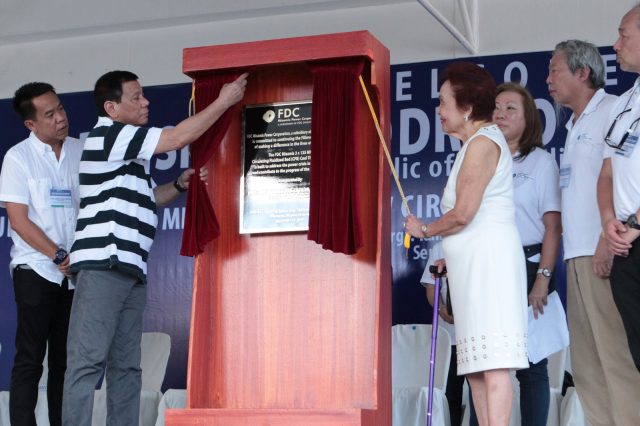DAVAO CITY (MindaNews / 26 Feb) — Non-renewable energy accounts for more than half of Mindanao’s power mix, a reversal from what it used to be at least a year ago when renewable energy, mostly hydro, contributed majority of the island’s power source, a December 2016 report from the Department of Energy (DOE) showed.
Romeo Montenegro, director for Investment Promotion, International Relations and Public Affairs of Mindanao Development Authority (MinDA), said the reversal was noted between late 2015 and early 2016, or the period when three major coal-fired power plants with a combined installed capacity of 700 megawatts (mw) were connected to the grid.
 President Rodrigo R. Duterte leads the unveiling of the inaugural marker of the Filinvest Development Corporation Misamis 405-MW coal-fired power plant in Villanueva, Misamis Oriental on September 22, 2016. KING RODRIGUEZ/PPD
President Rodrigo R. Duterte leads the unveiling of the inaugural marker of the Filinvest Development Corporation Misamis 405-MW coal-fired power plant in Villanueva, Misamis Oriental on September 22, 2016. KING RODRIGUEZ/PPD
Montenegro was referring to the AboitizPower Corp.’s 300-mw Therma South Inc. in Brgy. Binugao, Toril, the 300-mw coal-plant of the San Miguel Consolidated Power Corporation in Malita, Davao Occidental, and first 100-mw unit of the Alcantaga-led Sarangani Energy Corp. (SEC).
Of Mindanao’s total installed capacity of 3,162 mw, the contribution of the non-renewable energy is 1,898 mw (1,070 mw coal and 828 mw diesel), which accounts for 60 percent of the energy mix, while the renewable sources account only for about 40 percent with a contribution of 1,264 mw (108 mw geo-thermal, 1,061 mw hydro, 36 mw biomass, and 59 mw solar).
Majority of the hydro power source comes from the state-run Agus-Pulangui Hydro Power Complexes with an installed capacity of 982.1-mw and composed of seven plants – Agus 1, Agus 2, Agus 4, Agus 5, Agus 6, Agus 7, and Pulangui 4.
But Montenegro said hydro provides an unstable source of power as it generates power based on the amount of rainfall, which makes it less reliable for a baseload, or the power plants that can run 24/7.
As of February 26, 2017, National Grid Power Corporation (NGCP) reported Mindanao posted a surplus of 436 mw.
Among Mindanao’s major coal plants are the two-unit 232 mw STEAG State Power Inc. and another two-unit 270 mw Filinvest Group’s FDC Utilities, Inc., both in Misamis Oriental.
The first of two units of the Sarangani Energy Corporation was switched on last January 26, 2017 with President Rodrigo R. Duterte as the guest of honor. A groundbreaking for the second unit was also held on the same day.
“Science is good but technology is expensive. And Mindanao has had a shortfall for so many years of energy. We cannot develop until we have the power. And power is sometimes being challenged from all sides,” he said at that time.
For diesel, 59 mw Southern Philippines Power Corp. (SPPC) in Alabel, Sarangani, 32 mw SPC Power Corp., two plants of Therma Marine Inc. in Nasipit, Agusan del Norte and Maco, Compostela Valley with 100 mw each, 113 mw Western Mindanao Power Corp. in Zamboanga City, and 103 mw Mapalad Power Corp. in Iligan City in Lanao del Norte.
Chinkie Pelino-Golle, executive director of the Environmental group Interface Development Interventions (IDIS) said this is a backward development “given the fact that we used to have higher percentage of renewable energy sources.”
She said the government opened Mindanao for non-renewable instead of maintaining the hydropower plants.
“Instead of maintaining or enhancing it, the government opened the market for more non-RE sources that pose threat to people’s health and the environment. Even if they say they are applying the safe technology, we can’t really be sure of it. We don’t have the capacity and competence to conduct our own safety tests of these coal fired power plants,” she said.
She alleged the DOE failed to implement fully the Republic Act 9513, or the “Renewable Energy Act”, which promotes “the development, utilization and commercialization of renewable energy resources,” because “it if does, the non-renewable energy (RE) sources may have not outnumbered the RE sources in Mindanao.”
“We challenge them to present their RE plan as well as the concrete steps on how this will be implemented. They have to allocate funds for RE sources because this will help us gradually wean from hazardous energy sources such as CFPP (coal-fired power plant),” she said.
She said they support the local industrialization and development but it should be done in a way “will ensure protection and sustainable utilization of our resources and ensure that the future generation will also have safe and healthy environment.” (Antonio L. Colina IV / MindaNews)